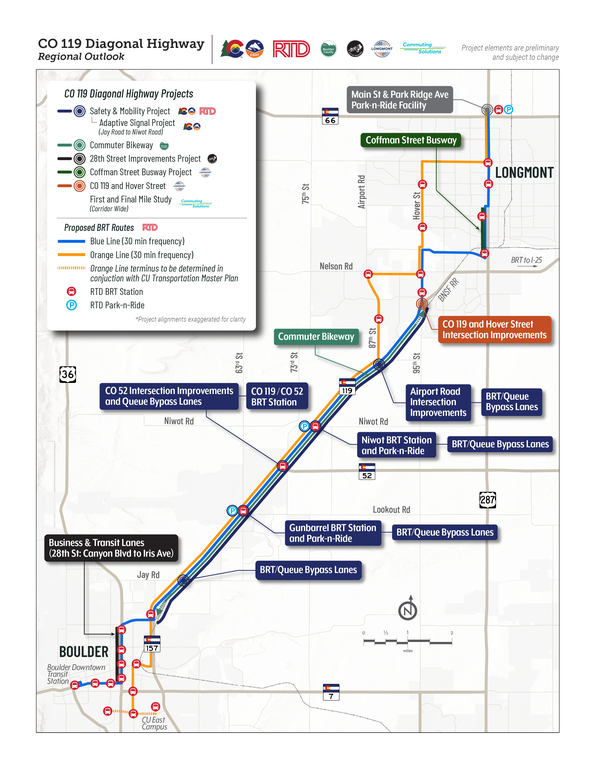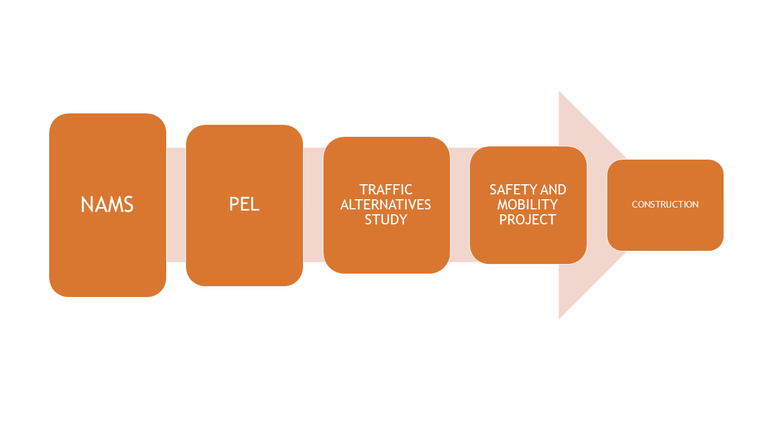Mobility in the Corridor
A Multimodal Vision
Northwest area stakeholders have established a multimodal vision through the CO 119 Multi-Modal Planning and Environmental Linkages (PEL) Study whereby people can safely and reliably access and move throughout the corridor by walking, bicycling, riding transit, and driving. The PEL Study identified numerous project elements being advanced as separate projects by corridor stakeholders.
CO 119 Safety, Mobility and Bikeway Improvements Project is being designed to integrate with these other projects on the Corridor:
- City of Boulder 28th Street Improvements Project
- Commuting solutions CO 119 First & Final Mile Study
- City of Longmont Coffman Street Busway
- City of Longmont Boston Avenue Connection
- City of Longmont 1st Avenue and Main Street Mobility Hub
CO 119 Diagonal Highway Regional Outlook

A regional outlook map of the CO 119 Diagonal Highway showing various projects and proposed BRT routes between Boulder and Longmont in Colorado. The map includes the following labeled elements:
CO 119 Diagonal Highway Projects
- Safety & Mobility Project
- Adaptive Signal Project (Jay Road to Niwot Road)
- Commuter Bikeway
- 28th Street Improvements Project
- Coffman Street Busway Project
- CO 119 and Hover Street Intersection Improvements
Proposed BRT Routes
- Blue Line (30 min frequency)
- Orange Line (30 min frequency)
- Orange Line terminus to be determined in conjunction with CU Transportation Master Plan
RTD Facilities
- RTD BRT Station
- RTD Park-n-Ride
The CO 119 leadership structure streamlines project development so projects are advanced in an efficient and cost-effective manner. Representatives from all organizations with active planning projects on the corridor between 2020 and the present meet monthly to ensure project coordination.
Boulder County, CDOT, and RTD have established a Community Advisory Committee for the Colorado Highway 119 corridor between Boulder and Longmont. Composed of ten community members who live and/or work near the corridor, the committee serves as a focus group for the development of Boulder’s Commuter Bikeway and CDOT’s and RTD’s CO 119 Safety, Mobility and Bikeway Improvements Project. The committee meetings are intended to ensure the projects are shaped by diverse voices from a variety of community member perspectives, including people of color, people with mobility challenges, people of all ages and abilities, people who rely upon transit, the strong and confident bike commuter, and people interested in bicycling but who are uncomfortable bicycling on roads.
Boulder County is one of the fastest growing areas of Colorado and area stakeholders have long advocated for improved transit to accommodate new residents and businesses. In 2014, RTD completed the Northwest Area Mobility Study (NAMS), which focused on developing consensus among RTD, CDOT, and northwest area stakeholders on cost-effective, immediate-term mobility improvements that address growing travel demand and improve mobility in the northwest region. NAMS identified the CO 119 corridor from Boulder to Longmont as a top candidate for prioritized transit service.
In 2019 RTD commissioned the CO 119 Multi-Modal Planning and Environmental Linkages (PEL) Study to implement the NAMS recommendation of optimizing regional connectivity and mobility between and within Boulder and Longmont by providing improvements that result in faster and more reliable transit travel. Whereas NAMS recommended a single Bus Rapid Transit route for the corridor, the PEL Study process determined that mobility improvements should encompass a multimodal corridor vision. To implement this vision, the PEL Study identified numerous project elements, including a commuter bikeway and first and final mile connectivity.
In reviewing the PEL Study, the Federal Highway Administration and Federal Transit Administration determined that a detailed traffic analysis is necessary before design could begin on the safety and highway capacity management improvements associated with the CO 119 Safety, Mobility and Bikeway Improvements Project. To meet this requirement, the Colorado Transportation Investment Office (CTIO) (previously HPTE) commissioned the Traffic Alternatives Study.
The Colorado Transportation Investment Office (CTIO) (previously HPTE) commissioned the Traffic Alternatives Study, a cost benefit analysis to identify the highway capacity management and transit priority improvements that best advance the CO 119 Multi-Modal Planning and Environmental Linkages (PEL) Study goals:
- Improving safety in the whole corridor
- Maximizing intersection operational efficiency
- Maximizing corridor-wide efficiency
- Maximizing the number of people able to move through the corridor
- Improving transit travel times
- Improving connectivity to the bicycle and pedestrian network
The Traffic Alternatives Study analyzed seven alternatives for year 2045 conditions:
- No Build
- Baseline (intersection improvements at CO 52, Hover, and Airport)
- Queue Bypass Lanes
- 3 General Purpose Lanes
- Tolled Express Lane (adding a new lane)
- Tolled Express Lane (converting existing lane to tolled express lane)
- Tolled Express Lane (grade-separated)
Safety was assessed by reviewing crash improvements, pedestrian exposure, bike exposure, and intersection and segment conflict points. Cost was added as an additional scoring element. Scores were weighted for safety, operations, and cost.
Study Findings:
- Intersection Improvements and Queue Bypass Lanes tie for the highest score in crash improvements, pedestrian exposure, bike exposure, and intersection and segment conflict points.
- Intersection Improvements (the Baseline) significantly improve corridor performance compared to the No-Build Alternative.
- Queue Bypass Lanes alternative is low cost and provides Bus Rapid Transit travel time savings and trip reliability.
- Tolled Express Lane Scenarios provide similar Bus Rapid Transit travel time savings and trip reliability as Queue Bypass Lanes, but at a significantly higher cost. Additionally, these scenarios increase the number of personal vehicles served in the corridor.
Recommendation:
Intersection Improvements and Queue Bypass Lanes are recommended to be advanced for design and implementation through the CO 119 Safety, Mobility and Bikeway Improvements Project.
To read the full Traffic Alternatives Study report by contacting the project team.
Stakeholder Collaboration:
Throughout the Traffic Alternatives Study, CTIO engaged all planning partners in the corridor including Boulder County, City of Boulder, City of Longmont, Commuting Solutions, Federal Highway Administration, RTD, and CDOT. Each of the corridor planning partners provided input and helped to guide the study process. The study’s findings were reviewed and discussed by the CO 119 leadership structure. This collaborative process led to the concurrence of the recommendations by all planning partner stakeholders. This level of collaboration provides a solid foundation for the CO 119 Safety, Mobility and Bikeway Improvements Project to move forward to design.
